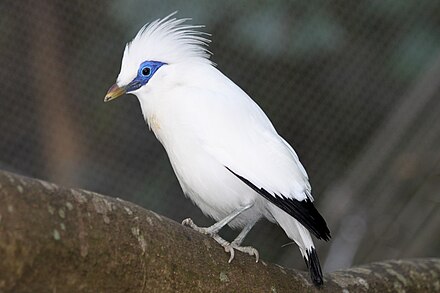Hoopoe starling
The hoopoe starling (Fregilupus varius), also known as the Réunion starling or Bourbon crested starling, is a species of starling that lived on the Mascarene island of Réunion and became extinct in the 1850s. Its closest relatives were the also-extinct Rodrigues starling and Mauritius starling from nearby islands, and the three apparently originated in south-east Asia. The bird was first mentioned during the 17th century and was long thought to be related to the hoopoe, from which its name is derived. Some affinities have been proposed, but it was confirmed as a starling in a DNA study.
The hoopoe starling was 30 cm (12 in) in length. Its plumage was primarily white and grey, with its back, wings and tail a darker brown and grey. It had a light, mobile crest, which curled forwards. The bird is thought to have been sexually dimorphic, with males larger and having more curved beaks. The juveniles were more brown than the adults. Little is known about hoopoe starling behaviour. Reportedly living in large flocks, it inhabited humid areas and marshes. The hoopoe starling was omnivorous, feeding on plant matter and insects. Its pelvis was robust, its feet and claws large, and its jaws strong, indicating that it foraged near the ground.
The birds were hunted by settlers on Réunion, who also kept them as pets. Nineteen specimens exist in museums around the world. The hoopoe starling was reported to be in decline by the early 19th century and was probably extinct before the 1860s. Several factors have been proposed, including competition and predation by introduced species, disease, deforestation, and persecution by humans, who hunted it for food and as an alleged crop pest.
The first account thought to mention the hoopoe starling is a 1658 list of birds of Madagascar written by French governor Étienne de Flacourt. He mentioned a black-and-grey "tivouch" or hoopoe; later authors have wondered whether this referred to the hoopoe starling or the Madagascan subspecies of hoopoe (Upupa epops marginata), which resembles the Eurasian subspecies. The hoopoe starling was first noted on the Mascarene island of Réunion (then called "Bourbon") by Père Vachet in 1669, and first described in detail by French traveller Sieur Dubois's in 1674:[2]
Hoopoes or 'Calandres', having a white tuft on the head, the rest of the plumage white and grey, the bill and the feet like a bird of prey; they are a little larger than the young pigeons. This is another good game [i.e., to eat] when it is fat.[3]
Early settlers on Réunion referred to the bird as "huppe", because of the similarity of its crest and curved bill with that of the hoopoe. Little was recorded about the hoopoe starling during the next 100 years, but specimens began to be brought to Europe during the 18th century. The species was first scientifically described by Philippe Guéneau de Montbeillard in the 1779 edition of Comte de Buffon's Histoire Naturelle, and received its scientific name from Dutch naturalist Pieter Boddaert for the book's 1783 edition. Boddaert named the bird Upupa varia; its genus name is that of the hoopoe, and its specific name means "variegated", describing its black-and-white colour.[2]




_-_Réunion_Starling_-_specimen_-_video.webm/440px-seek=2-Naturalis_Biodiversity_Center_-_RMNH.AVES.110050_-_Fregilupus_varius_(Boddaert,_1783)_-_Réunion_Starling_-_specimen_-_video.webm.jpg)

